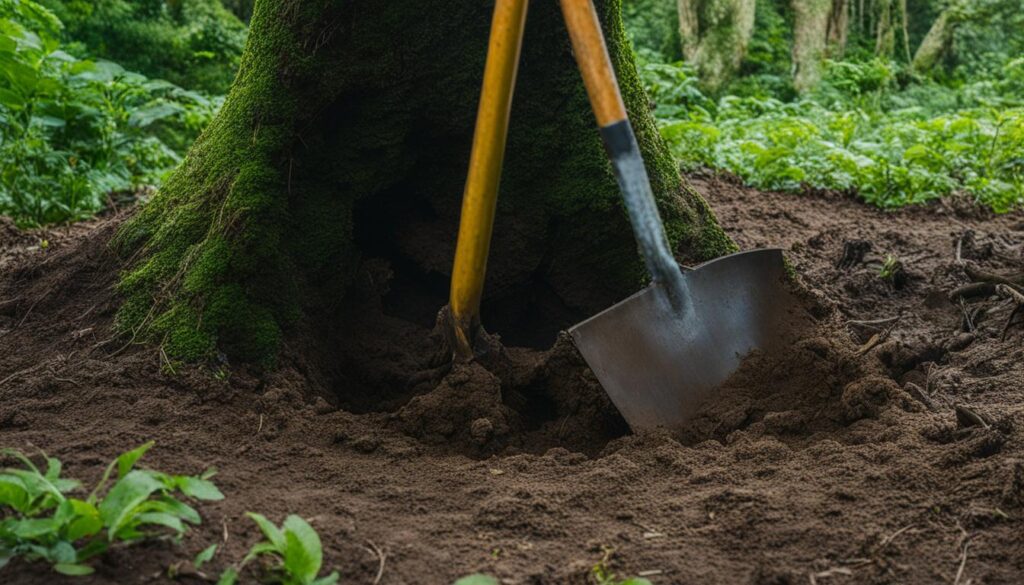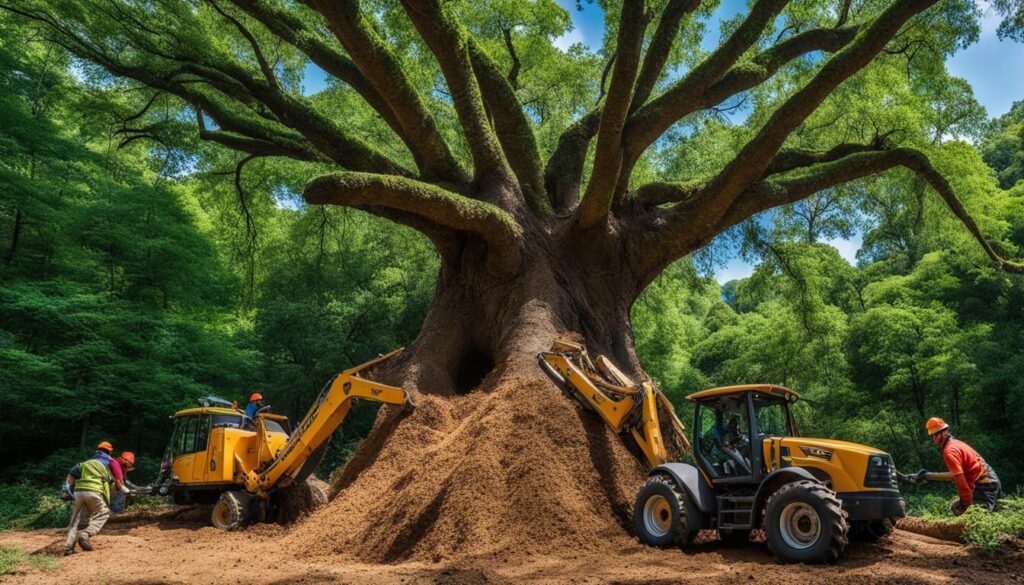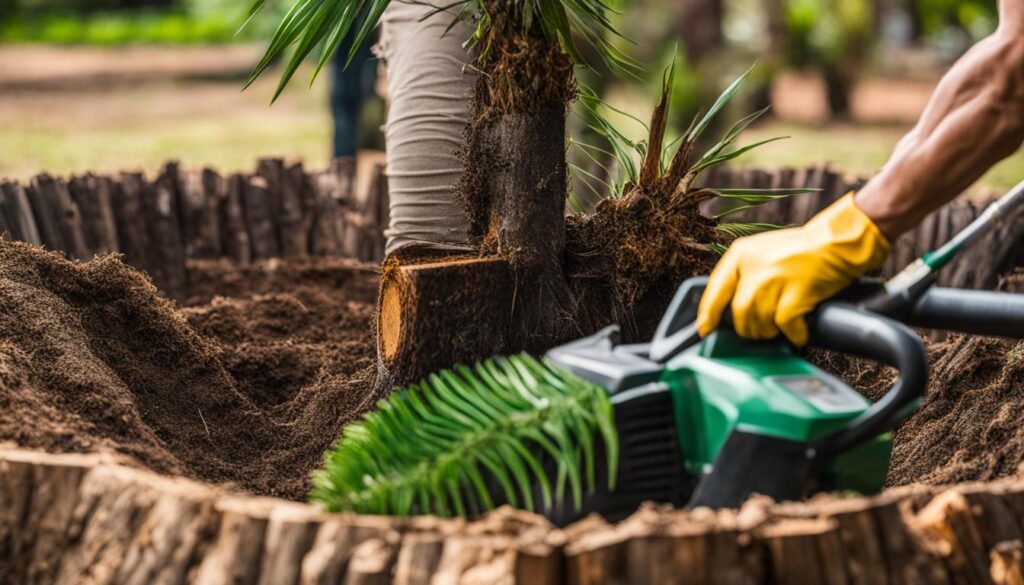Stump removal is often seen as the final chapter in the life of a tree, but it’s also the prologue to new beginnings with planting new trees. As I delved into the practices of tree planting, I uncovered that while the essence of a tree may have gone, the space it leaves behind can be the birthplace of new life. Yet, this is not a task to be undertaken lightly; the soil has a story that impacts the future actors of the land. Can you simply introduce new beginnings where old roots lay? The complexity of this question becomes evident when the intricacies of soil health enter the stage.
The task of planting a tree in the same location as a stump once stood demands an understanding of the transformed soil composition and the hidden challenges it may harbor. From nutrient depletion to possible soil contaminants from the stump removal process, I’ll take you through the careful considerations necessary for ensuring that your efforts in tree planting will bloom into robust, healthy growth.
Key Takeaways
- Assessing soil health is crucial following stump removal when planning to plant new trees.
- Understanding how past trees affect soil is key for successful tree planting.
- Soil contaminants and residual root systems can hinder the growth of new trees.
- Prior stump removal may necessitate soil amendments to restore its vitality.
- Nurturing new life requires patience and thorough preparation for planting new trees.
Understanding the Dynamics of Soil Post-Tree Stump Removal
As I delve into the complexities of regenerative landscapes, specifically the transformational period following the removal of a tree stump, it’s essential to understand how this process affects the very foundation of future growth: the soil itself. The intricate balance within the subterranean ecosystem is disrupted not just by the absence of the tree stump that once anchored life, but by the changes in soil dynamics that ensue.
The Impact of Previous Trees on Soil Health
Former trees play a significant role in the health and structure of soil, both in life and after their removal. Their extensive root systems once pulled nutrients upwards, fostering a unique compilation of microorganisms and influencing moisture retention and pH levels. One may not initially perceive this, but tree stump health before removal often dictates the quality of the remaining soil. When a stump is excavated or ground out, it’s not merely the visible wood that’s subtracted from the equation, but also the legacy of nutrient extraction and water dynamics left behind.
Dealing with Potential Soil Contaminants Post-Stump Removal
Stump removal techniques, although they vary from manual uprooting to chemical treatment, all leave a mark on the subsequent condition of the soil. Particularly with chemical decomposers, I’m wary of potential soil contaminants that can linger long after the stump itself is gone. These substances could range from herbicides to salt-based compounds that degrade soil quality, stalling the ambitions of planting anew. Addressing these contaminants is a chase against time and toxicity—a careful balance to restore soil to its native fertility and ensure it can support another round of life. Indeed, patience is not merely a virtue but a necessity for those awaiting the soil’s return to its former glory, ready for new growth to take root.
Can You Plant a Tree Where a Stump Was Removed
As a gardening enthusiast, I’ve faced the question many times: is planting a tree where a stump was removed a viable option? The answer is affirmative; yet, meticulous steps must be taken to ensure that the new tree can prosper. Immediately after tree planting after stump removal, you might encounter challenges related to soil conditions that were influenced by the former tree. One of the first tasks I undertake is to clear the area of any sawdust and organic remnants. This is crucial because such debris can harbor microorganisms that compete for nutrients, potentially limiting the growth of your new tree.
Creating a welcoming home for your new tree involves more than just digging a hole. I recommend enriching the site with fresh, fertile soil and adding rich organic matter to promote healthy root development. Attention to detail during the planting process and ongoing care are instrumental for the tree’s growth stages. My experience has proven that, with the right preparation, patience, and persistence, your new tree can thrive, turning a once-stump-ridden spot into a vibrant part of your landscape. Let’s not forget, ensuring the success of any tree planting venture starts with giving your new sapling the best possible start in its new environment.
The Role of Stump Grinding in Tree Planting
As an avid gardener, I’ve come to understand the critical role of stump grinding in the preparation of a garden space for new tree planting endeavors. From personal experience, I know this process can significantly influence the soil’s condition and the overall environment, thus impacting the success of adding fresh foliage to the landscape.
How Stump Grinding Affects the Planting Site
Stump grinding invariably reshapes the landscape, leaving behind a mixture of wood chips and soil. I’ve observed this mix to occasionally deplete nitrogen levels in the soil, as decomposing wood consumes this vital nutrient. It’s a fact to consider when planning for tree planting, as the altered nitrogen levels may necessitate a recalibration of soil fertility before introducing a new sapling.
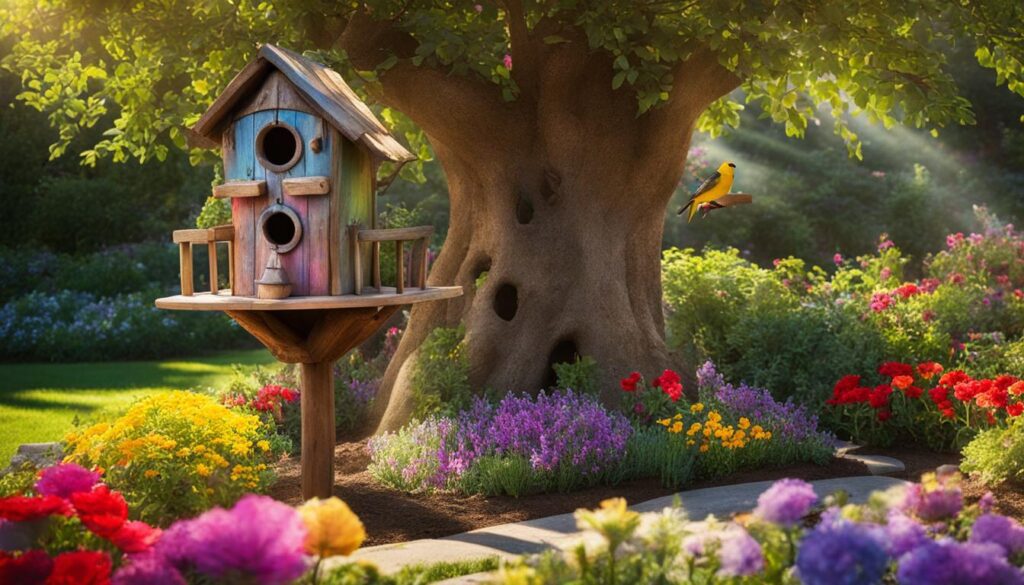

Alternative Uses for Tree Stumps in Landscaping
In my journey of gardening, I have found that the remains of stumps offer an untapped potential for creative landscaping. Carving hollowed-out tree stumps into charming flower beds, or leveraging them as bases for mushroom cultivation adds a touch of imaginative whimsy to a garden. These applications not only recycle the stump but also contribute to the ecological richness of the garden, proving that with a bit of creativity, even a stump, often seen merely as a remnant of the past, can find new purpose.
Preparing the Site for a New Tree After Old Tree Removal
As I set out to refresh the landscape after a thorough tree stump removal, I recognize the importance of detailed site preparation to ensure succulent growth for my new arboreal additions. Emphasizing such preparation is critical, as it paves the way for planting trees after stump removal with heightened chances of success. It’s not simply about removing what’s left of the old; it’s about fostering the perfect environment for the new.
Post-grinding efforts must be meticulous, as residual sawdust and wood chips are notorious for their nitrogen-hogging tendencies. These remnants can disrupt the balance of nutrients necessary for a fledgling tree, so I ensure each particle is cleared from the soil. The space is then ready for an infusion of nutrient-rich topsoil and possibly compost, establishing a fertile ground for my garden’s next inhabitant. Vigilance in these early stages of **site preparation** is what will transition the soil from a graveyard of old roots to a cradle of new life.
Conscious of the delicate interplay of elements beneath the surface, I approach the task with a respect that goes beyond mere planting. By restoring the territory once occupied by the old tree, I embrace the subsequent phase of sowing anew. Understanding that patience is a complement to effort, I anticipate watching the resilient sapling rise, marking the completion of a cycle that began with **tree stump removal** and culminated in the delicate art of **planting trees after stump removal**.
Nourishing New Life: Planting a Tree in a Former Tree’s Territory
Embarking on the journey of tree planting in the space left behind by a previous tree kindles a new chapter of growth. As I explore the nuances of establishing a new arborous resident, I am deeply committed to applying **best practices in tree planting**. Nourishing new trees in areas where old ones once stood is not just a matter of digging a hole and placing a sapling; it’s an intricate dance with nature’s conditions, requiring mindfulness towards the legacy left in the soil and the ecological tapestry into which the new tree must weave itself.
Selecting the Right Tree for Your Terrain
My first task in this green endeavor is **proper tree selection**. Choosing a specimen that aligns with the unique characteristics of the terrain ensures a synergy between the tree and its new home. This includes understanding the soil’s pH, texture, and the remnant nutrients from its predecessor. It is also important to consider hardiness zones and potential pathogens present in the environment, forming a symbiotic relationship from the outset.
Best Practices for Planting a Tree Where a Stump Was Removed
Once the appropriate species is chosen, the focus shifts to **best practices in tree planting**. I take great care to provide the sapling with ample space for its roots to expand and to eschew laying sod or grass in close proximity to the planting hole. Meticulous watering is essential to oust air pockets and to settle the soil around the new roots—a step that is as nurturing as it is necessary. By heeding these practices, I not only foster the tree’s survival but also its ability to thrive where another once grew, ushering in a new era of life and growth.
Addressing the Hidden Dangers: Diseases and Pests
When I consider the health of my garden and the trees within it, I must turn a critical eye to the legacy left by their predecessors. Tree diseases, pests, and soil pathogens are formidable adversaries to healthy tree growth, often lurking invisibly in the very soil where we hope to cultivate new life. Through my experience, I’ve learned that the key to a flourishing tree begins long before the first roots even touch the soil; it starts with an understanding of its underground nemesis.
From the silent spread of root rot to the insidious creep of soilborne fungi, the remnants of diseases past can imperil the vibrancy of a newly planted sapling. My strategy includes a rigorous inspection of the soil, uprooting the remnants of disease that could otherwise hinder the growth of new trees. I pay close attention to signs of common afflictions, such as wilting leaves or discolored bark, which could indicate lurking pests or diseases.
But the fight against these hidden dangers doesn’t end with mere identification—I actively engage in thwarting their advances. By removing diseased material and replenishing the earth with nutrient-rich soil, I ensure that the next generation of trees has the fortitude to resist the threats beneath their roots. I am mindful of selecting tree varieties that not only beautify my landscape but are also resilient against the specific challenges presented by my soil’s history.
Finally, I remain vigilant, mindful that the best defense lies in proactive care. Regularly checking my trees for signs of distress, engaging in preventative maintenance, and fostering a strong and diverse ecosystem are all part of my ongoing commitment to fostering an environment where trees can grow strong, resilient, and healthy.
Recommended Distance Between a New Tree and a Removed Stump
As I delve into the realm of landscape planning, a critical element that demands attention is the planting distance that should be maintained between a new tree and a previously removed stump. Drawing from my extensive experience in garden design, I can attest to the importance of this consideration for the prosperity of the newly planted tree. To circumvent the complications associated with encountering old root systems, it is generally advocated to allocate a space of six to eight feet from the removed stump when planting a new tree.
This mindful approach not only facilitates tree and stump separation but also guarantees that the sapling will have ample territory for root expansion and uninhibited access to essential nutrients. By honoring this guideline, I engender an environment that serves as the bedrock for the new tree’s vigorous growth and longevity.
Successfully integrating new trees into a space once dominated by another requires foresight and accurate execution. In my experience, this proactive landscape planning is the linchpin ensuring that the emerald tapestry of our gardens continues to thrive with each generation of trees we plant.
Amending Soil for Success: Fertilizers and Amendments
After the arduous process of stump removal, I find myself playing the role of a restorative custodian to my garden. It’s imperative to assess the soil’s current state if I want the next tree to thrive. Through experience, I’ve learned that **soil fertility** is a dynamic characteristic, changing with each tree’s lifecycle. Removing a stump can leave soil exhausted, lacking in essential nutrients. Hence, amending soil becomes not just an act of gardening but a necessary step for tree growth.
Soil amendments and fertilizers are my allies in this process. They replenish the earth and create the ideal conditions for the next generation of trees. By incorporating the right mix of organic matter and formulated fertilizers, I can address the nutrient balance and structure of the soil, setting the stage for robust tree growth.
Assessing Soil Fertility and Corrective Measures
My first move is to scrutinize the nutrient content and pH of the soil, getting a clear picture of what’s missing and what’s abundant. Quick-release fertilizers offer an immediate boost to nutrient levels, while slow-release variants ensure a steady supply, encouraging sustained growth. It’s a fine balance, tailored to the unique demands of the landscape.
The Ideal Soil Mixture for Tree Planting After Stump Removal
The optimal concoction for nurturing new life in place of the old is a blend of rich compost, fortified by strategic injections of nitrogen-rich fertilizers. This combination creates an ecosystem that not only welcomes a new tree but also bolsters the surrounding flora. It helps to decompose any lingering roots and propels forward the cycle of growth. My hands become a bridge between the past and the future as I mix, amend, and prepare the soil for its next charge – a sapling that will rise where an old tree once stood.
Consulting with Arborists: Professional Insights into Tree Planting
When I faced the task of rejuvenating my landscape after a tree stump removal, I understood it was not just about filling a void in the earth. I sought arborist consultation to navigate the intricate journey of planting anew. Engaging with certified arborists provided me with professional tree planting advice, vital in making informed decisions about my land.
Knowing that tree roots can extend far beyond the stump, their guidance was indispensable in picking suitable species that could thrive in my unique soil composition. The arborist services didn’t just end with the selection process; they also offered long-term care strategies to ensure the new tree’s growth and the overall vitality of my garden.
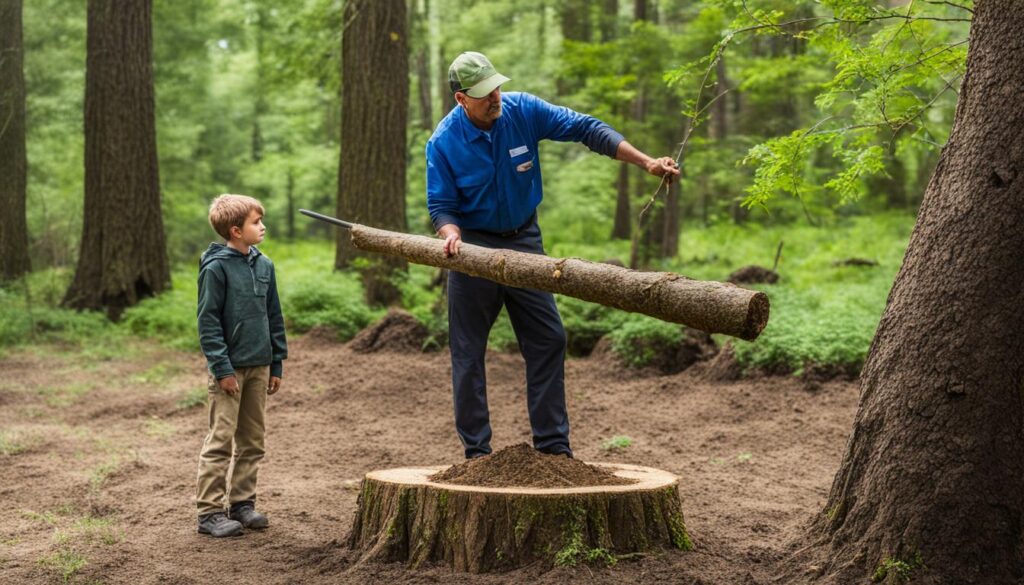

From the depth of the planting hole to optimal watering techniques, arborists’ insights were a beacon that lighted my path, allowing me to understand the nuances involved in establishing a robust tree life where once there was a stump. Because of their localized knowledge, my landscape is now not just restored but invigorated with the potential for flourishing biodiversity.
Conclusion
My journey through the intricate process of planting anew in the site of a former tree has encapsulated the essence of revitalizing landscapes with careful consideration. I’ve gained invaluable knowledge on the influence of previous flora on future growth, unveiling that soil health is a pillar of success when replacing old with new. This experience has taught me the significance of preparation and selection—choosing the right tree species for my unique soil conditions ensures that I approach planting with the confidence and vision that the task demands.
Revitalizing Your Landscape with Confidence
As I reflect on the steps outlined in this guide, one thing remains clear: the confidence to refresh and beautify my outdoor space comes from understanding that patience in planting is non-negotiable. Whether I’m dealing with remnants of an old stump or nourishing the ground for my next green venture, the embodiment of patience allows the natural course of regrowth to unfold favorably. Moreover, engaging with professional arborists leverages their expertise, infusing my efforts with the assurance necessary to cultivate a landscape that flourishes with life and vitality.
The Value of Patience and Proper Planning in Tree Planting
In embracing planning in tree planting, I’ve acknowledged that rushing to see immediate greenery cannot compare to the lasting satisfaction of observing a tree I’ve planted thrive over time. Each step, from the initial stump removal to the nurturing of young saplings, embodies the commitment to fostering life within my cherished external environment. As such, I remain dedicated to thoughtfully engaging with each phase, recognizing that true revitalization is achieved not just in the physical transformation, but in the conscientious effort invested along the way.
FAQ
Can you plant a tree where a stump was removed?
Yes, planting a tree where a stump was removed is possible, but it requires careful consideration of the soil conditions that have been altered due to the presence and removal of the previous tree. Successful planting involves soil treatment, proper site preparation, and sometimes a waiting period for the soil to recover.
How does the previous tree impact soil health?
The previous tree may have extracted essential nutrients from the soil, altered water content levels, and its decomposing roots can have significant ecological impacts. As a result, the remaining soil may be less nutrient-rich and host microorganisms that compete for resources with the new tree.
Are there potential contaminants in the soil after stump removal?
Yes, the use of salts or chemicals for stump removal can introduce contaminants into the soil. Such contaminants may make the soil inhospitable for new plantings until it has had time to recover.
What role does stump grinding play in tree planting?
Stump grinding is a method of tree stump removal that can affect the potential planting site by leaving behind sawdust and disturbing soil balance. However, the sawdust can also be used for mulching and other purposes in landscaping.
How can tree stumps be creatively used in landscaping?
Tree stumps can be transformed into unique garden features such as planter boxes, seating elements, or even substrates for growing mushrooms. These innovative uses can integrate naturally into your garden’s ecosystem.
What site preparations are needed after old tree removal?
Preparing the site includes removing leftover sawdust and wood chips, which could bind nitrogen needed by plants. The soil may also need supplementation with topsoil and compost to ensure a nutrient-rich environment for the new tree.
How do you select the right tree species for planting where a stump was removed?
It is crucial to select a tree species that is compatible with the specific soil conditions and resistant to any pathogens that might have affected the previous tree. Understanding the site’s microclimate and soil composition assists in making an informed decision.
What are the best practices for planting a tree where a stump was removed?
Best practices include clearing the area of debris, ensuring quality soil is used for planting, allowing ample space for roots to establish, and providing proper moisture. Ensuring these conditions can help the new tree establish itself and thrive.
What hidden dangers from diseases and pests should be considered when planting a new tree?
There’s a possibility that diseases or pests that afflicted the old tree could remain in the soil and pose threats to a new tree. Identifying and removing any diseased remnants and considering the environmental needs of the new tree can mitigate these risks.
What is the recommended distance between a new tree and a removed stump?
A minimum distance of six to eight feet between the new planting and the removed stump is recommended. This buffer ensures the new tree has enough space for root expansion and proper nutrient absorption without competing with old roots.
How do I assess soil fertility and what corrective measures should be taken?
Soil fertility can be assessed through soil testing to measure pH levels and nutrient content. Based on the results, corrective measures might include adding specific fertilizers or organic matter to restore soil health conducive to tree growth.
What is the ideal soil mixture for planting a tree after stump removal?
The ideal soil mixture should include a balance of good topsoil, possibly enriched with compost or other organic material, and should address any specific nutrient deficiencies identified in soil testing.
Should I consult with an arborist before planting a new tree?
Consulting with a certified arborist can provide valuable insights into the selection of an appropriate tree species, site preparation, stump removal process, and long-term tree care to ensure the health and growth of the new tree.

